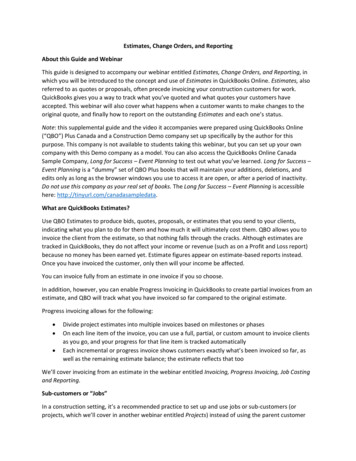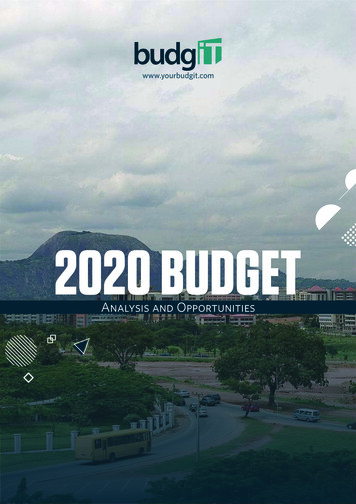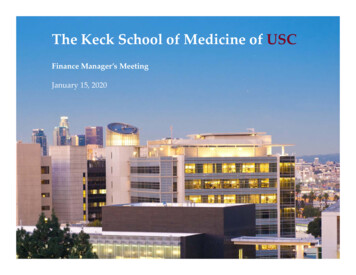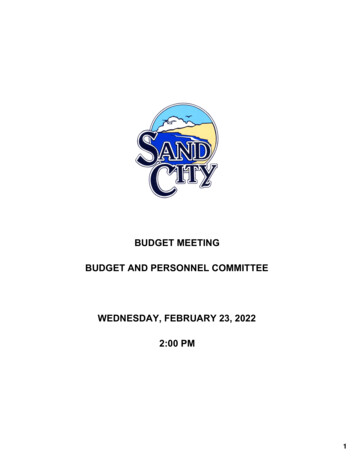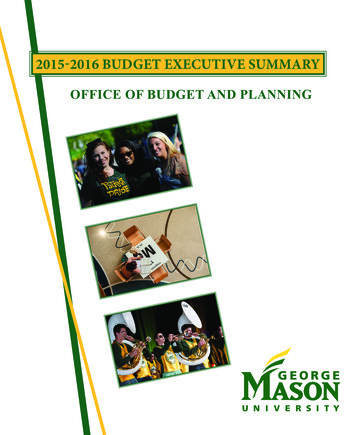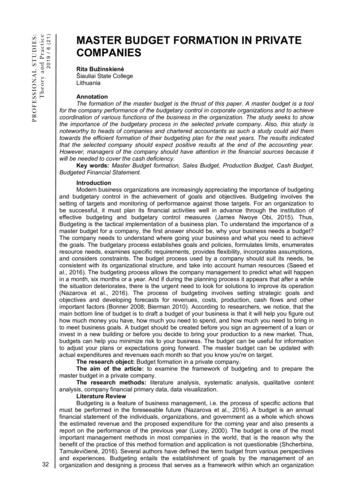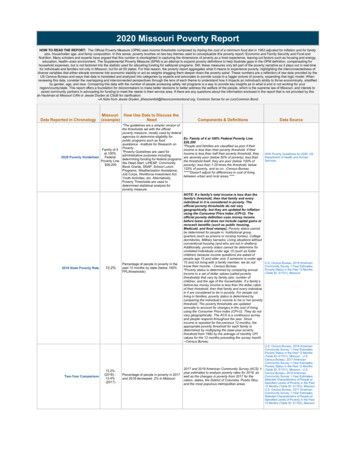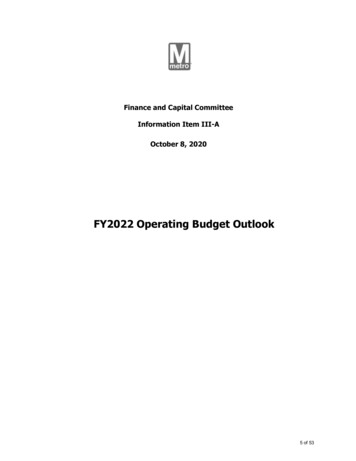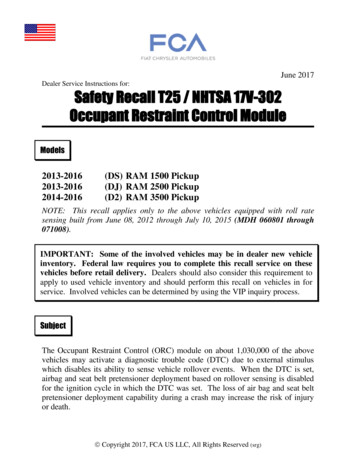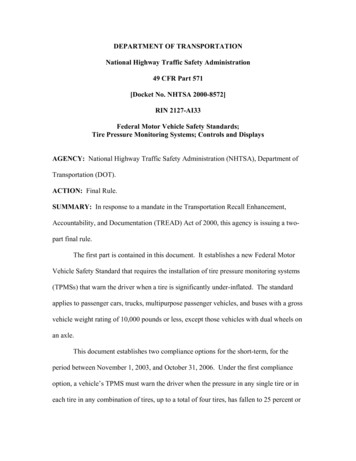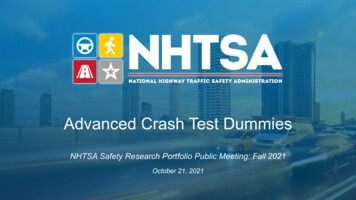
Transcription
BUDGETESTIMATESFISCAL YEAR 2020NATIONAL HIGHWAYTRAFFIC SAFETYADMINISTRATIONSUBMITTED FOR THE USE OFTHE COMMITTEES ON APPROPRIATIONS
This Page Left Intentionally BlankThis age Left Intentionally Blank
Section I: OverviewTable of ContentsOverview . 1FY 2019 Organizational Chart . 6FY 2020 Organizational Chart . 7Section II: Budget Summary TablesComparative Statement of New Budget Authority (Exhibit II-1) . 9Budgetary Resources by Appropriation (Exhibit II-2). 10Budgetary Resources by Strategic Goal (Exhibit II-3) . 11Budget Authority (Exhibit II-4) . 12Outlays (Exhibit II-5) . 13Analysis of Change Table (Appropriations, Obligation Limitation, and ExemptObligations) (Exhibit II-6) . 14Working Capital Fund (Exhibit II-7) . 18Full-time Equivalent Employment (FTE) (Exhibit II-8) . 19Full-time Permanent Position (FTP) (Exhibit II-9) . 20Section III: Budget Request by AccountAppropriation Language – Operations and Research - Vehicle Safety . 21Appropriation Language – Operations and Research - Highway Safety R&D. 22Appropriation Language – Highway Traffic Safety Grants . 23Administrative Provisions . 24Vehicle Safety – Summary by Program Activity (Exhibit III-1) . 25Vehicle Safety Program and Performance Statement . 26Vehicle Safety Research & Analysis Detailed Justification by Program Activity . 29Rulemaking Detailed Justification by Program Activity . 47Enforcement Detailed Justification by Program Activity . 55Vehicle Safety Administrative Expenses Summary . 64
Highway Safety R&D – Summary by Program Activity (Exhibit III-1) . 65Highway Safety R&D Program and Performance Statement . 66Highway Safety Programs Detailed Justification by Program Activity. 68National Center for Statistics & Analysis Detailed Justification by Program Activity . 107Highway Safety R&D Administrative Expenses Summary . 120Highway Traffic Safety Grants – Summary by Program Activity (Exhibit III-1) . 121Highway Traffic Safety Grants Program and Performance Statement . 122Highway Traffic Safety Grants Detailed Justification by Program Activity . 126Highway Traffic Safety Grants Administrative Expenses Summary . 142Ten-Year Appropriation History . 145Section IV: Research, Development and TechnologyRD&T Request (Exhibit IV-1) . 151Section V: Information Technology ExpenditureFY 2020 Information Technology Funding Summary. 153Modal IT Justification Narrative . 156
National Highway Traffic Safety AdministrationFY 2020 Budget RequestDeputy Administrator’s OverviewNational Highway Traffic Safety AdministrationFY 2020 Budget by Program 151,000,000 155,300,000Vehicle Safety ProgramsHighway Safety Research andDevelopmentHighway Traffic Safety Grants 623,017,000The National Highway Traffic Safety Administration’s (NHTSA) mission is to save lives, preventinjuries, and reduce economic costs due to road traffic crashes, through education, research, safetystandards, and enforcement activity. NHTSA’s Fiscal Year (FY) 2020 budget request of 929.32million supports the full spectrum of the agency’s vehicle and behavioral safety activities.Advancements in automotive technology and vehicle innovation have created new possibilities andoffer enormous safety potential for all road users in the United States.However, the data remind us that three facts remain in traffic safety: Nearly half (47 percent) of all passenger vehicle occupants killed in crashes are unbelted; 1More than a fourth (29 percent) of highway crash fatalities involve an alcohol-impaired driver; 2andAccording to the crash causation survey, the critical reason for the crash is attributed to the driverin the majority of the cases. 3In 2017, the Nation lost 37,133 people in traffic crashes. 4 Additionally, preliminary data for 2018reflects a flat trend in fatalities.2017 Fatal Motor Vehicle Crashes: Overview DOT HS 812 6032017 Fatal Motor Vehicle Crashes: Overview DOT HS 812 6033Singh, S. (2015, February). Critical reasons for crashes investigated in the National Motor Vehicle Crash CausationSurvey. (Traffic Safety Facts Crash Stats. Report No. DOT HS 812 115). Washington, DC: National Highway TrafficSafety Administration.42017 Fatal Motor Vehicle Crashes: Overview DOT HS 812 603121
NHTSA’s FY 2020 budget request includes 151.00 million for Vehicle Safety, 155.30 million forHighway Safety Research and Development, and 623.02 million for Highway Traffic Safety Grants.This budget request is critical to NHTSA’s ongoing efforts to improve safety for all road users andenhance NHTSA’s recall and enforcement efforts. NHTSA can never put a price on a life lost, but theagency estimates that motor vehicle crashes imposed 836 billion in U.S. economic costs and societalharm in 2010 alone. 5 This FY 2020 budget request addresses these costs.The automotive industry is in the midst of a technological revolution that promises to improve safetyand expand mobility for millions of Americans. NHTSA must ensure the testing and safe deploymentof driver assistance technologies, and the FY 2020 budget request supports the agency’s ability to doso. Furthermore, in the past few years, NHTSA undertook the largest vehicle recalls in the agency’shistory.The FY 2020 budget request will allow NHTSA to address driver behaviors in ways that reduceinjuries and fatalities on our roadways; continue its efforts in rulemaking, enforcement, and vehicleresearch; and develop and implement data-driven, workable, and self-sustaining highway safetyprograms. This budget request enables the agency to work effectively with its Federal, State, local,and private sector partners to achieve the greatest reduction possible in roadway crashes, injuries, andfatalities. These entities play vital roles in reducing injuries and fatalities on our Nation’s roadways.Public and private sector partnerships work to enforce laws against drunk and distracted driving,provide technical assistance on graduated driver licensing and other safety issues, and support highvisibility activities that save lives.Priority AreasVehicle SafetyNHTSA’s mission is ensuring the Nation’s roadways are safe, and safe vehicles are a vital componentof preventing crashes and the resulting injuries and fatalities. The FY 2020 budget requests 151.00million to continue advancing the Vehicle Safety efforts initiated over the past several years. Therequested funding will allow NHTSA to build on existing research in advanced technologies, continuecritical rulemaking efforts and build enforcement capacity to protect drivers around the country.The FY 2020 budget request proposes a realignment of research activities that have historically beenaddressed under the Vehicle Safety account, but in fact address issues related to driver behavior thatare appropriate under the Highway Safety Research & Development account. As automationadvances, NHTSA’s critical safety research must be responsive to the changing technologicallandscape. To a greater degree than ever before, the study of human machine interfaces and howhuman drivers react to advanced driver assistance systems is a critical component of ensuring vehiclesafety. The proposed programmatic realignment acknowledges this reality. In FY 2020, 7.00 millionof research into the nexus between driver behavior previously funded out of the Vehicle Safetyaccount is shifted to the Highway Safety Research and Development account. Specifically, 2.00million from Advanced Driver Assistance Systems (ADAS), 3.00 million from Automated DrivingSystems (ADS), and 2.00 million to improve behavioral response rates to vehicle recalls, areproposed for realignment.5The Economic and Societal Impact of Motor Vehicle Crashes, 2010. National Highway Traffic Safety Administration.2
In FY 2020, the amount requested for the ADS program will concentrate NHTSA’s resources on themost promising safety-enhancement segment of automation, Society of Automotive Engineers (SAE)Levels 4 and 5. Reflecting the Secretary’s priorities of safety and innovation, coupled with the rapidlyevolving technological and regulatory landscape, the agency’s request targets resources to support thesafe testing, development, and deployment of ADS. NHTSA will undertake activities that supportand maintain the United States’ global leadership in the safe deployment of automated vehicles byempowering private sector innovation and focusing on collaboration, uniformity and interoperabilityto accelerate testing, validation and deployment of new life-saving technologies. Through ongoingcollaboration with industry, NHTSA will address the barriers that challenge the rollout of higher-levelADS in the United States. These systems have the potential to address the high percentage of seriouscrashes where the critical reason for the crash is attributed to driver choice or error. Althoughsuccessful deployment of these technologies promise a new level of safety, they also present a newset of challenges. To maximize safety and protect the American public, it is imperative that NHTSAkeeps pace with rapid technological progress. The requested resources are essential to address newchallenges while maintaining agency efforts that support NHTSA’s safety mission.In FY 2020, NHTSA has proposed renaming several existing research programs to reflect theagency’s focus on innovation and priority of preparing for the future. In the budget, research effortsin safety systems and biomechanics are merged to form a new Crashworthiness research category. Asvehicle design evolves, it is important to update crash test and simulation tools (e.g., crash testdummies) that can measure and address severe and frequent injuries that cannot be measured withcurrent tools. Updating these tools through biomechanics research coupled with applied research toimplement their use will be critical to laying the foundation for increasing vehicle occupant andvulnerable road user protection in the future.The requested funding in NHTSA’s Vehicle Safety Research program will also support ongoingresearch into complex safety-critical electronic control systems; vehicle cybersecurity; and new andemerging technologies that can help drivers avoid crashes. The Advanced Safety Technologies areafocuses on light vehicle ADAS research (formerly crash avoidance research) and Heavy VehicleSafety Technologies research. Examples of safety technologies addressed in this research areainclude: intersection safety assist, head on collision avoidance systems, blind spot intervention, andrear cross traffic alert. NHTSA’s Vehicle Electronics and Emerging Technologies research programhas been renamed “Vehicle Electronics and Cybersecurity” to better reflect the research intent.Although these changes appear cosmetic, they are indicative of NHTSA’s focus on the future. Asautomated safety technologies have matured and been introduced to the market in new vehicles, sotoo have NHTSA’s efforts to ensure the safety and reliability of these systems become moredeveloped and robust. NHTSA continues to keep pace with advancements and remains committed tothe safety of the American public, both in and around vehicles. These proposed changes reflect thatcommitment.In addition to work on ADAS and ADS technologies, NHTSA’s FY 2020 request also supportsNHTSA’s continued efforts on mandated regulations, such as enhancing motor coach and childpassenger safety authorized by the Moving Ahead for Progress in the 21st Century Act (MAP-21)(P.L. 112-141), and work on alternative fuel vehicles. For rulemaking activities to establish averagefuel economy standards, the Secretary of Transportation retains primary and final decision-makingauthority. In consultation with the Administrator of the Environmental Protection Agency and asdelegated to NHTSA, the Department of Transportation prescribes or amends the Corporate Average3
Fuel Economy (CAFE) program requirements under the Energy Conservation Policy Act of 1975 andthe Energy Independence and Security Act of 2007 (EISA). These efforts include: Continuing to conduct analytical work to support light, medium and heavy-dutyvehicle fuel economy rulemakings for future years; andContinuing development and maintenance of the CAFE Management Suite includinghosting, software and contract labor costs.The FY 2020 request also reflects the need for increased funding for NHTSA’s enforcement program.With several high profile recalls in recent years, NHTSA is appropriately prioritizing the Office ofDefects Investigation with the requested increases. Activities critical to the agency’s ability to removeunsafe motor vehicle equipment from the nation’s roadways include: ongoing operation andmaintenance for Information Technology (IT) systems related to recall management; improved datamining and analytical capabilities to screen for and investigate defects; and developing newassessment processes for driving automation systems. Enforcement programs will also continueensuring industry compliance with motor vehicle safety standards, investigating safety-related defectsin motor vehicles and motor vehicle equipment, and enforcing the Federal odometer law.Highway SafetyThe FY 2020 budget requests 155.30 million for NHTSA’s behavioral safety programs where theagency will prioritize educating roadway users and community leaders to adopt safe behaviors, inconjunction with strong laws and effective law enforcement.NHTSA will continue to engage with law enforcement officers, prosecutors, and judges in agencybehavioral programs. These partnerships are crucial to the success of the agency’s efforts to betterunderstand and influence driver behavior. NHTSA will continue to mobilize and enable a network ofpeer outreach Law Enforcement Liaisons (LELs) to advance its programs and provide ongoingtechnical assistance to law enforcement officials at the State and local level. NHTSA will also supportthe Data-Driven Approaches to Crime and Traffic Safety (DDACTS) program, and will continue itsresearch initiatives in the areas of drug-impaired driving and driver fatigue.Within the request, 5 million in funding is prioritized in FY 2020 to continue NHTSA’s DrugImpaired Driving Initiative that began in FY 2018. Funding will support critical research needed tobetter understand how drug use and impairment impact driver safety. It is vitally important that weidentify methods to detect drug use and driver impairment that identify the best way to measure theextent drugs affect driving behaviors. As the only Federal agency mandated to improve driver safety,NHTSA must be able to provide accurate and reliable data for planning, evaluation and researchpurposes. The initiative will also provide increased education and training for all segments of thecriminal justice system; expand the national media campaign on drug-impaired driving; and developnew resources and technical assistance to strengthen State and community drug-impaired drivingprograms.In the FY 2020 budget request, NHTSA is clarifying the shift in funding for human behavioralelements and adaptations, as well as improving responses to safety recalls from the Vehicle Safetyaccount to the Highway Safety Research and Development account. Specific behavioral researchactivities traditionally funded under the Vehicle Safety program are allowable under the S. 403Highway Safety Research and Development program. These activities will focus on Automated4
Driving Systems (ADS) Human Factors research, Advanced Driver Assistance Systems (ADAS)research, and the Recall Management program administered by the Office of Defects Investigation.The National Center for Statistics and Analysis (NCSA) will continue the collection and analysis ofcrash data to identify safety problems and trends, and assess costs, benefits, and effectiveness ofprograms and regulations. The data gathering and statistical analysis performed by NCSA is thebackbone of NHTSA’s behavioral initiatives. In FY 2020, NCSA will support upgrades to datascience tools and a new crash causation study.NCSA will maintain its core programs, including the Fatality Analysis Reporting System (FARS),and continue the rollout of the modernized Crash Report Sampling System (CRSS) and CrashInvestigation Sampling System (CISS). Key ongoing initiatives include: providing FastFARS data to on a quarterly basis (in addition to the yearly reporting for theFARS System);updating annual projections of motor vehicle traffic fatalities;conducting on-site and remote crash investigations to identify unintended consequences ofvehicle-related crashes or incidences;supporting potential recalls and other agency enforcement efforts; andimproving data quality and analytical methods including electronic data transfer and newanalytical tools to support and improve NHTSA data accessibility.Highway Traffic Safety GrantsThe FY 2020 budget requests 623.02 million for Highway Traffic Safety Grants. Authorized underthe Fixing America’s Surface Transportation (FAST) Act (P.L. 114-94), the Highway Traffic SafetyGrants account continues the grant programs established under Moving Ahead for Progress in the 21stCentury Act (MAP-21) (P.L. 112-141) and as modified under the FAST Act. Through theseprograms, including the Section 402 State and Community Highway Safety Program and the Section405 National Priority Safety Programs, and the Section 1906 Racial Profiling Data Collection Grants,the agency provides grants to States and local governments that are critical to the success of NHTSA’sbehavioral and data programs. Additionally, the High Visibility Enforcement program will continueto provide funding for NHTSA’s annual Click It or Ticket and Drive Sober or Get Pulled Over, andIf You Feel Different, You Drive Different: Drive High, Get A DUI media campaigns that have proveneffective in reducing injuries and fatalities on our Nation’s highways.ConclusionNHTSA’s FY 2020 budget request of 929.32 million will continue to support the agency’s safetyprograms and activities, while ensuring that the agency keeps pace with rapid innovation in vehicleelectronics, and full spectrum of driving automation systems. To maximize driver safety, criticalresearch must be able to inform smart rulemaking while proactive enforcement efforts efficientlyremove defective equipment from our highways. Efforts to understand driver behavior and assistdrivers in making better choices, from remembering to wear seatbelts and avoid distractions, tochoosing not to drive while impaired continue to be priorities as well. Funding at the requested levelwill allow NHTSA to continue helping all Americans drive, ride, and walk safely.5
Office ofChiefFinancial Officer( 30 / 30 )Office ofChief Counsel( 38 / 38 )AssociateAdministrator forAdministration( 27 / 27 )Office ofChiefInformation Officer( 27 / 27 )Region 5Olympia Fields, ILRegion 3Baltimore, MDRegion 1Cambridge, MARegion 8Lakewood, CORegion 6Fort Worth, TXRegion 4Atlanta, GARegion 2White Plains, NYAssociateAdministratorRulemaking( 55 / 55 )Office ofCivil Rights(6/6)FY 2019 FTE EstimateNational Highway Traffic Safety Administration(Total 626 FTE/626 FTP)Associate AdministratorRegional Operations &ProgramOffice of Administrator( 11 / 11 )AssociateAdministratorResearch &ProgramDevelopment( 57 / 57 )Office ofGovernmental Affairs,Policy &Strategic Planning(6/6)AssociateAdministratorCommunications &ConsumerInformation( 29 / 29 )Region 7Kansas City, MORegion 10Seattle, WAGrantsManagement &OperationsRegion 9Sacramento, CARegional Operations & Program Total( 88 / 88 )AssociateAdministratorEnforcement( 121 / 121 )AssociateAdministratorVehicle SafetyResearch( 56 / 56 )AssociateAdministratorNational Centerfor Statistics &Analysis( 75 / 75 )
Office ofChiefFinancial Officer( 30 / 30 )Office ofChief Counsel( 38 / 38 )AssociateAdministrator forAdministration( 27 / 27 )Office ofChiefInformation Officer( 20 / 20 )Region 5Olympia Fields, ILRegion 3Baltimore, MDRegion 1Cambridge, MARegion 8Lakewood, CORegion 6Fort Worth, TXRegion 4Atlanta, GARegion 2White Plains, NYAssociateAdministratorRulemaking( 55 / 55 )Office ofCivil Rights(6/6)FY 2020 FTE EstimateNational Highway Traffic Safety Administration(Total 619 FTE/619 FTP)Associate AdministratorRegional Operations &ProgramOffice of Administrator( 11 / 11 )AssociateAdministratorResearch &ProgramDevelopment( 57 / 57 )Office ofGovernmental Affairs,Policy &Strategic Planning(6/6)AssociateAdministratorCommunications &ConsumerInformation( 29 / 29 )Region 7Kansas City, MORegion 10Seattle, WAGrantsManagement &OperationsRegion 9Sacramento, CARegional Operations & Program Total( 88 / 88 )AssociateAdministratorEnforcement( 121 / 121 )AssociateAdministratorVehicle SafetyResearch( 56 / 56 )AssociateAdministratorNational Centerfor Statistics &Analysis( 75 / 75 )
This Page Left Intentionally Blank8
EXHIBIT II - 1FY 2020 COMPARATIVE STATEMENT OF NEW BUDGET AUTHORITYNATIONAL HIGHWAY TRAFFIC SAFETY ADMINISTRATION( 000)FY 2018ACTUALSACCOUNT NAMEOperations and Research Vehicle Safety Programs (GF)FY 2019ANNUALIZED CRFY 2019ENACTEDFY 2020REQUEST349,575 352,675 356,100 306,300189,075189,075190,000151,000Sec. 143 - Highway Safety Research & Development (GF)Highway Safety Research & Development Highway Traffic Safety Grants (TF)701,895712,557715,232623,017Highway Traffic Safety Grants 02412Transfer from FHWATOTAL 1,051,470 1,065,232 1,071,332 Note: Totals may not add due to rounding.1.Sec. 143 of the FY 2019 Consolidated Appropriations Act (P.L. 116-6) is formerly Sec. 144 of the FY 2018 ConsolidatedAppropriations Act (P.L.115-141).2.NHTSA anticipates transfers from FHWA in FY 2020. Amounts to be determined based on State penalty information.9929,317
EXHIBIT II-2FY 2020 TOTAL BUDGETARY RESOURCES BY APPROPRIATION ACCOUNTNATIONAL HIGHWAY TRAFFIC SAFETY ADMINISTRATIONAppropriations, Obligation Limitations, and Exempt Obligations( 000)ACCOUNT NAMEVEHICLE SAFETY PROGRAMS (GF)RulemakingEnforcementResearch and AnalysisAdministrative Expenses1SEC. 143 - HIGHWAY SAFETY RESEARCH AND DEVELOPMENT (GF)Railhead Media CampaignImpaired DrivingHIGHWAY SAFETY RESEARCH AND DEVELOPMENT (TF)Highway Safety ProgramsResearch and Analysis - NCSAAdministrative ExpensesTOTAL OPERATIONS AND RESEARCH(A)(B)(C)(D)FY 2018ACTUALSFY 2019ANNUALIZED CRFY 2019ENACTEDFY 2020REQUEST 189,075 24,54532,15448,86683,510189,075 24,54532,15448,86683,510190,000 6,067 11,500 6,5005,000149,000 57,37439,94151,68511,500 6,5005,000149,000 57,37439,94151,68514,000 7,0007,000152,100 56,63140,29055,179155,30063,12142,98349,196 349,575 349,575 356,100 102,349105,024HIGHWAY TRAFFIC SAFETY GRANTSSection 402 Formula GrantsSection 2009 High Visibility Enforcement ProgramSection 405 National Priority Safety ProgramsSection 405 Occupant Protection GrantsSection 405 State Traffic Safety Information System GrantsSection 405 Impaired Driving Countermeasures GrantsSection 405 Distracted Driving GrantsSection 405 Motorcyclist Safety GrantsSection 405 State Graduated Driver Licensing LawsSection 405 Non-Motorized Safety Pedestrian/BikesAdministrative Expenses26,329Transfer from 50,09824,3024,28914,29514,29526,817-TOTAL HIGHWAY TRAFFIC SAFETY GRANTS (TF) 701,895 699,978 715,232 623,017TOTAL 1,051,470 1,049,553 1,071,332 929,317Note: Totals may not add due to rounding.1.2.Sec. 143 of the FY 2019 Consolidated Appropriations Act (P.L. 116-6) is formerly Sec. 144 of the FY 2018 Consolidated Appropriations Act (P.L.115-141).NHTSA anticipates transfers from FHWA in FY 2020. Amounts to be determined based on State penalty information.10
EXHIBIT II-3FY 2020 BUDGET REQUEST BY DOT STRATEGIC AND ORGANIZATIONAL GOALSAppropriations, Obligation Limitation, and Exempt ObligationsNATIONAL HIGHWAY TRAFFIC SAFETY ADMINISTRATION( 000)ACCOUNT talVehicle Safety Programs (GF)Highway Safety Research & Development (TF)Highway Traffic Safety Grants (TF) 133,279151,002623,017 - 13,153- 4,5674,298- 151,000155,300623,017TOTAL 907,298 - 13,153 8,866 929,31711
EXHIBIT II-4FY 2020 BUDGET AUTHORITYNATIONAL HIGHWAY TRAFFIC SAFETY ADMINISTRATION( 000)(A)Mandatory/DiscretionaryACCOUNT NAMEVehicle Safety Programs (GF)D(B)FY 2018FY 2019ACTUALS ANNUALIZED CR(C)(D)FY 2019ENACTEDFY 2020REQUEST 189,075 189,075 190,000 151,000 189,075 189,075 190,000 151,000 11,500 11,500 14,000 11,500 11,500 14,000 149,000 152,100 152,100 155,300 149,000 152,100 152,100 155,300 701,895 712,557 715,232 623,017Highway Traffic Safety Grants (TF) 597,629 610,208 610,208623,017Transfer from FHWA2 104,266TOTAL: 1,051,470Vehicle Safety Programs (GF)1Sec. 143 - Highway Safety Research & Develop. (GF)DSec. 143 - Highway Safety Research & Develop. (GF)Highway Safety Research & Develop. (TF)MHighway Safety Research & Develop. (TF)Highway Traffic Safety Grants (TF)M102,349 1,065,232 105,024 1,071,332 scretionary]200,575200,575204,000151,000Note: Totals may not add due to rounding.1.Sec. 143 of the FY 2019 Consolidated Appropriations Act (P.L. 116-6) is formerly Sec. 144 of the FY 2018 Consolidated Appropriations Act (P.L.115-141).2.NHTSA anticipates transfers from FHWA in FY 2020. Amounts to be determined based on State penalty information.12
EXHIBIT II-5FY 2020 OUTLAYSNATIONAL HIGHWAY TRAFFIC SAFETY ADMINISTRATION( 000)Vehicle Safety Programs (GF)M /DD(A)(B)(C)(D)FY 2018ACTUALS 174,000FY 2019ANNUALIZED CR 145,000FY 2019ENACTED 149,000FY 2020REQUEST 144,000Highway Safety Research & Development (TF)D 152,000 154,000 155,000 161,000Highway Traffic Safety Grants (TF)D 687,000 699,000 701,000 684,000M 1,000 1,014,000 13,0001,011,000 13,0001,018,000 41,000 1,030,000 1,000 1,013,000 13,000998,000 13,0001,005,000 Next Generation 911 Implementation Grants 0
EXHIBIT II-6SUMMARY OF REQUESTED FUNDING CHANGES FROM BASENATIONAL HIGHWAY TRAFFIC SAFETY ADMINISTRATIONAppropriations, Obligation Limitations, and Exempt Obligations( 000)SUMMARY TABLEBaseline ChangesFY 2018ActualsNHTSA SUMMARYFY 2019Annualized CRFY 2019EnactedAnnualization of2019 Pay RaisesAnnualization of2019 FTEFY 2020 PayRaiseOne moreCompensableDays (262)GSA RentWCFIncrease /DecreaseInflation /DeflationFY 2020BaselineEstimateProgramIncreases /DecreasesFY 2020RequestPERSONNEL RESOURCES (FTE)Direct Program FTEReimbursable FTETotal Direct and Indirect INANCIAL RESOURCESADMINISTRATIVE EXPENSESSalaries and Benefits (11 & 12)*Travel (21)Transportation of Things (22)GSA Rent (23)Rent, Communications & Utilities (23)Printing (24)Other Services (25)Supplies (26)Equipment (31)Subtotal, 11,025164,787VEHICLE SAFETY AND HIGHWAY SAFETY 0007,000(14,000)(7,000)(7,000)--(7)1VS VS VS HS HS -RulemakingEnforcementResearch and AnalysisHighway Safety ProgramsResearch and Analysis2SEC 143Railhead Media CampaignImpaired DrivingHIGHWAY TRAFFIC SAFETY GRANTS3Sec. 402 Formula GrantsSec. 2009 High Visibility EnforcementSection 405 National Priority Safety ProgramsSection 405 Oc
NHTSA's FY 2020 budget request includes 151.00 million for Vehicle Safety, 155.3million for 0 Highway Safety Research and Development, and 623.02 million for Highway Traffic Safety Grants.
